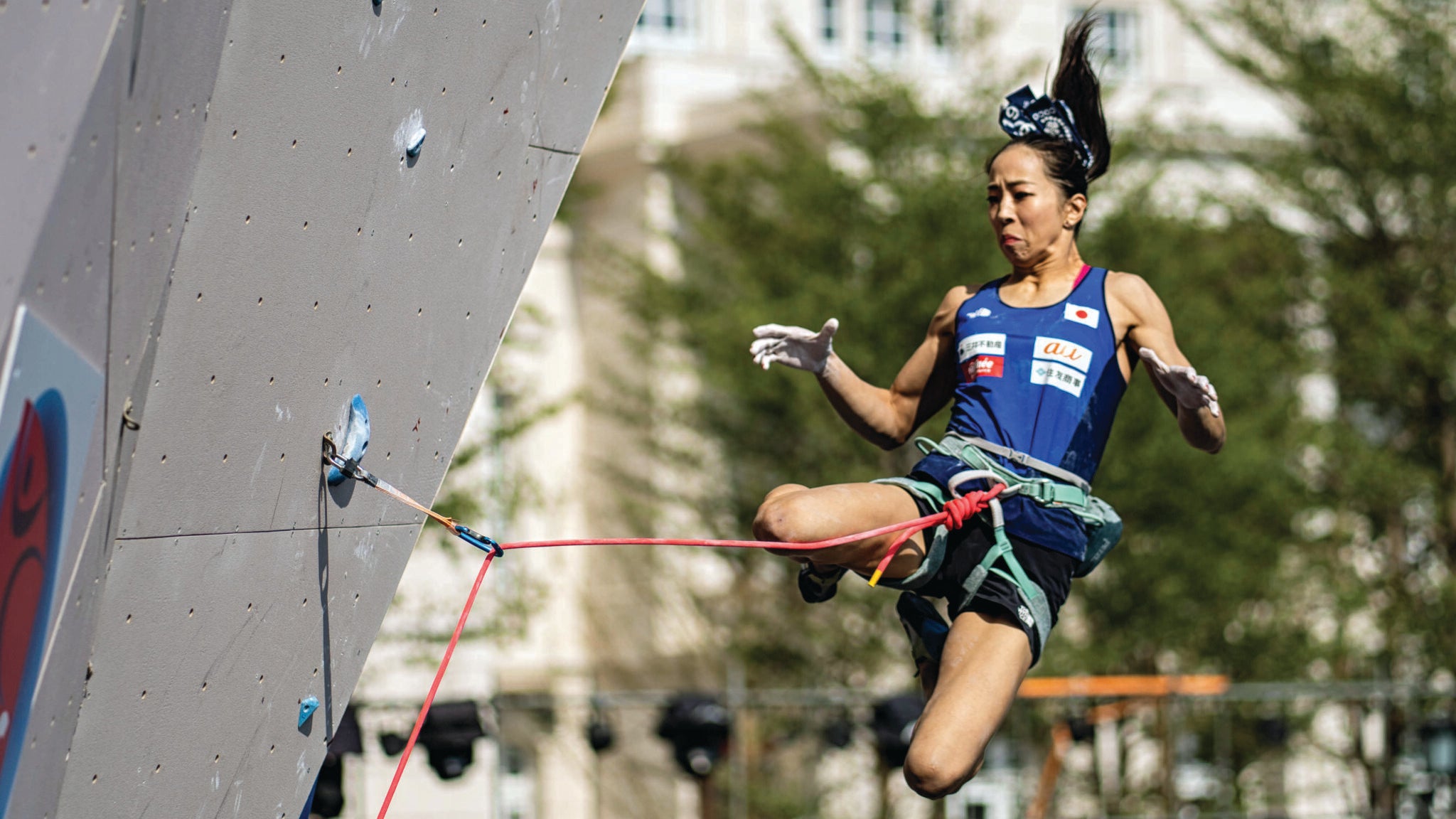Looking to Lead Climb? Here's How to Take and Catch Falls

Akiyo Noguchi (JPN) mid-whip at the 2019 Xiamen Lead World Cup. (Photo: Eddie Fowke / IFSC)

Even an experienced climber might feel a few nerves during a belay test, and many have tales of blowing it and being denied the coveted certificate. But, you passed! End goal? Far from it. There’s belaying, and then there’s catching falls. And falling.
Every climbing facility has its baseline requirements to lead climb and belay. Yet passing a belay check should be the first of many steps in gaining experience and honing your safety skills.
Lead climbing and belaying effectively involve many nuances. Below is a brief list of things we can (and should) constantly work on to become better climbers, belayers and partners.
Falling while on Lead
As a lead climber, you need to be prepared for a fall at any moment. Here are two things you can control, even after peeling off that sloper or missing your deadpoint to the next jug:
Eyes
Your eyes dictate the movements of your body. If you barn-door off the wall and look over your shoulder while rotating away from the wall, your body is likely to follow. Instead, when you fall, look down between your legs at the wall, which will help orient your body in a position better suited to a soft landing.
Body Position
After you fall, your goal should be to end up in a sitting position. When you come in contact with the wall, your feet are ideally planted a little more than hips-width apart, knees bent to absorb the impact. Hands may be up in front of your face to protect it against large holds or roofs, but should otherwise not be involved in bracing the fall.
Lead Belayers
Priority number one, of course, is keeping your climber off the ground, but an experienced belayer knows many other skills are involved in giving a solid lead belay.
Dynamic Belaying
On any busy evening in the gym, look around at the lead belayers and note how many have their feet planted and are stationary for the duration of their partners’ climbs. While a static belay is appropriate for top-roping, when lead belaying you want to be mobile and give a dynamic belay. Everything about the lead-climbing system is dynamic; from the ropes to falls, and your belaying should align.
Choosing to be close to the wall with less slack out while your leader is low to the ground dramatically reduces the chance of a groundfall, while taking a step back when the climber is higher up allows you more freedom of movement. Stepping towards or away from the wall while belaying can help you to feed the rope efficiently and securely and to take up slack with minimal effort and less work moving rope through a belay device unnecessarily. A good rule of thumb is to stand within a body length of the wall at any time while lead belaying.
Finally, making micro adjustments is key to giving a dynamic belay. From anticipating a clip and preparing to step in and feed out slack to quickly taking in a few inches after the climber clips, great belayers are constantly moving and looking for ways to be more dynamic.
How to Give a Soft Catch

Please stop spiking your climber. We’ve all been climbing when all of a sudden, with a loud THUD, a climber slams into the wall nearby. I cringe every time I hear that sound, because I know from experience how unpleasant a hard catch can be. Not only are they painful, hard catches can lead to broken or sprained ankles.
A common misconception is that more slack equals a softer catch. Yet in that scenario the climber usually free falls until the rope comes tight, then abruptly stops at the end of the rope.
Here are some guidelines to giving a softer catch: If you are lighter than your climber, focus on having minimal slack, and be prepared to be pulled up into the wall. Don’t resist! Even being 50 pounds lighter is not enough to pull against the catch. If you are a comparable weight to your climber (+/- 15 pounds) be prepared with minimal slack and “go with” or give a slight jump when the rope comes taut. This will help decelerate your climber slowly, instead of abruptly stopping the person. If you are heavier than your climber (>20 pounds) you should introduce slightly more slack and you MUST jump when the rope comes taut.
Slightly more slack gives you the time necessary to react and jump at the appropriate moment when you feel the tug on your belay loop from your rope tightening. If the timing of your jump is off, the catch will not be as soft as it could be.
Communicate Better
Climbing communication goes well beyond verbal climbing commands.
Whenever you belay, another climber is literally putting their life in your hands. Take this responsibility seriously. Focus 110 percent on the climber. That conversation with the next group over regarding post-send beers can wait. Be vigilant in belaying, and anticipate the climber’s needs. Beforehand, ask your partner if they anticipate any difficult sections. There are numerous different ways to communicate, and it is your job as the belayer to support your climber in the best ways possible.
There is always more for all of us to learn. We should continually seek to increase our knowledge and refine our skills to be better (and safer) lead climbers and belayers.
Brent Smith is Assistant Director of Instruction, Earth Treks and Planet Granite, AMGA Single-Pitch Instructor